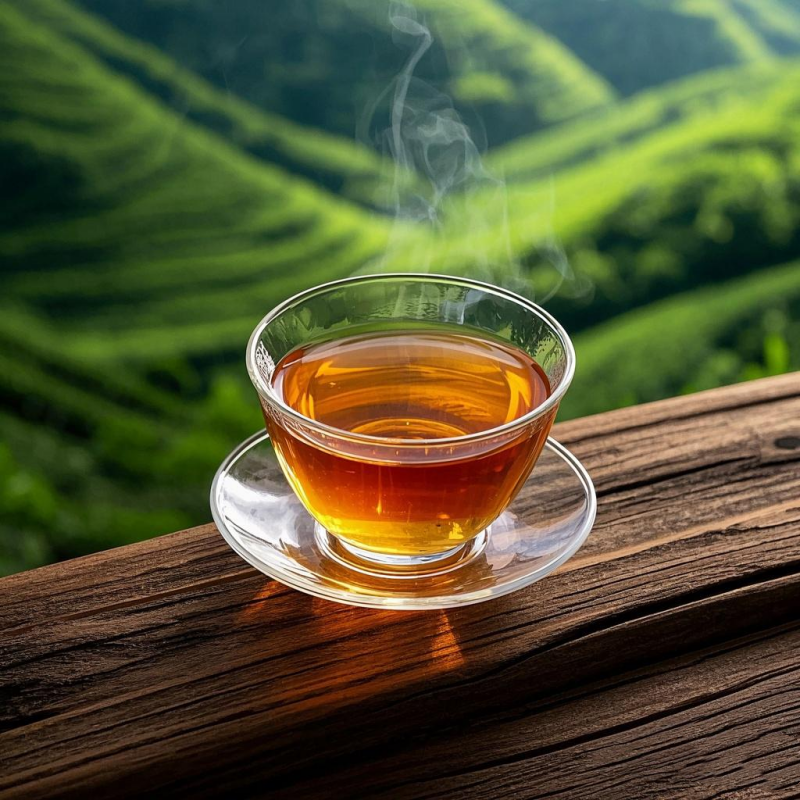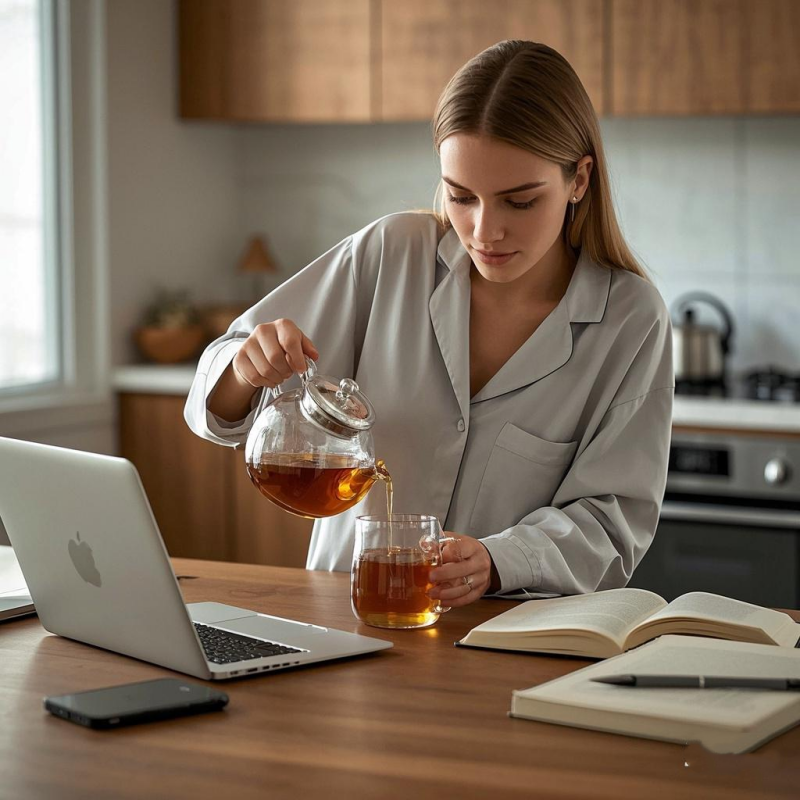Ultimate Oolong Tea Guide (2025 Global Edition)
What is Oolong Tea
Definition and Partial Fermentation Process
Oolong tea represents a masterful middle ground between green and black teas, characterized by its partial fermentation process. This semi-oxidized tea undergoes oxidation levels ranging from 20-80%, creating a complex flavor profile that varies dramatically based on processing techniques.
The key distinction lies in the fermentation control: light roast oolongs (20-30% oxidation) maintain floral, delicate notes; medium roast varieties (40-60% oxidation) develop fruity and creamy characteristics; while heavy roast oolongs (70-80% oxidation) showcase deep, cocoa-like and mineral flavors.
Oolong vs Green/Black Tea: Quick Comparison
| Tea Type | Oxidation Level | Flavor Profile | Caffeine Content (mg/cup) |
| Green Tea | 0-10% | Fresh, grassy, vegetal | 25-50 |
| Oolong Tea | 20-80% | Complex, floral to roasted | 30-50 |
| Black Tea | 90-100% | Bold, malty, astringent | 40-70 |
The partial fermentation gives oolong its signature complexity, offering both the freshness of green tea and the depth of black tea in a single cup.
Major Producing Regions and Representative Teas
Fujian, China: Wuyi Rock Teas
Fujian’s Wuyi Mountains produce some of the world’s most celebrated oolongs. Da Hong Pao (Big Red Robe) leads as the most famous, offering rich, mineral-driven flavors with notes of chocolate and stone fruit. Rou Gui (Cinnamon) provides spicy warmth, while Shui Xian (Water Sprite) delivers floral elegance with lasting sweetness.
These rock teas benefit from the region’s unique terroir—mineral-rich soil and misty climate create the distinctive “yan yun” (rock rhyme) characteristic.
Guangdong Phoenix Dan Cong: Aromatic Varieties

Phoenix Single Bush teas from Guangdong showcase incredible aromatic diversity. The naming system reflects their unique fragrance profiles: Huang Zhi Xiang (Gardenia Fragrance), Mi Lan Xiang (Honey Orchid Fragrance), and Zhi Lan Xiang (Iris Fragrance) represent just a fraction of the varieties.
Each dan cong theoretically originates from a single tea bush, though modern production often involves small groups of related plants. This approach preserves genetic diversity and creates distinct flavor signatures.
Taiwan Oolong: High Mountain Excellence
Taiwan’s high-altitude regions produce some of the world’s finest oolongs. Dong Ding remains a classic, offering creamy texture with notes of butter and honey. Oriental Beauty (Bai Hao) showcases natural sweetness enhanced by beneficial insect damage, creating unique muscatel flavors.
High Mountain oolongs (Gao Shan Cha) grown above 1,000 meters develop exceptional complexity due to temperature variations and slower growth rates, resulting in concentrated flavors and natural sweetness.
Emerging Regions: Thailand and Vietnam
The oolong market reached $6.08 billion in 2024, with new producing regions contributing to this growth. Thailand’s high-altitude regions produce quality oolongs at competitive prices, often offering excellent value for newcomers. Vietnamese oolongs, particularly from the northern mountains, provide accessible entry points while maintaining traditional processing methods.
Flavor and Aroma Mapping
Understanding Roast Levels
Light Roast (Clear & Sweet Floral): These oolongs retain green tea characteristics with prominent floral notes, natural sweetness, and bright acidity. Examples include Taiwan High Mountain oolongs and lightly processed Tieguanyin.
Medium Roast (Fruity & Creamy): Balanced oxidation creates stone fruit flavors, creamy mouthfeel, and gentle sweetness. Traditional Dong Ding and moderate Phoenix dan congs exemplify this category.
Heavy Roast (Cocoa & Mineral): Extended roasting develops deep, complex flavors including chocolate, coffee, and mineral notes. Wuyi rock teas and heavily roasted Tieguanyin demonstrate this profile.
Tea Cultivar Influences
Different tea plant varieties significantly impact flavor. Qing Xin (Green Heart) cultivar produces clean, floral notes common in Taiwan oolongs. Tieguanyin variety creates the signature creamy texture and complex aromatics, while Huang Jin Gui (Golden Osmanthus) offers distinctive peachy sweetness.
Health Benefits and Effects: Research-Supported Benefits
Antioxidants and Polyphenols

Research shows that the polyphenols in oolong tea lower blood sugar levels. They also reduce insulin resistance, making it potentially beneficial for metabolic health. The partial fermentation process preserves significant antioxidant content while creating unique polyphenol compounds not found in other tea types.
Researchers found that men who drank 1 or more cups of oolong tea per day had a lower risk of heart disease, though more research is needed to establish definitive cardiovascular benefits.
Caffeine and Energy Alternatives
Oolong tea contains approximately 30 mg–40 mg of caffeine compared to coffee’s 100-180mg. This moderate caffeine content provides gentle energy without the jitters often associated with coffee consumption.
Oolong tea, but not caffeine, stimulates fat oxidation, suggesting unique metabolic benefits beyond its caffeine content. However, these effects should be viewed as part of an overall healthy lifestyle rather than a standalone solution.
Complete Brewing Guide
Home Mug Method: Simple and Accessible
For everyday brewing, use 1 teaspoon (2-3g) of loose oolong per 8oz of water. Light oolongs benefit from 185°F (85°C) water for 3-4 minutes, while darker roasts can handle 205°F (95°C) for 4-5 minutes. This method produces a balanced cup suitable for daily consumption.
Gaiwan/Gongfu Method: Multiple Infusions
Traditional Chinese brewing maximizes oolong’s complexity through multiple short steeps. Use a 1:15 tea-to-water ratio (approximately 7g tea for 100ml water). First infusion: 30 seconds, increasing by 10-15 seconds for subsequent brews. Quality oolongs can provide 8-12 flavorful infusions.
Cold Brewing and Iced Preparations
Cold brewing reduces bitterness and highlights sweetness. Use a 1:8 ratio (12g tea to 1 liter cold water) and steep for 8-12 hours refrigerated. This method creates smooth, refreshing tea perfect for hot weather.
For ice brewing, place tea leaves in a vessel with ice cubes on top. As ice melts, it slowly extracts delicate flavors, creating an exceptionally clean and sweet brew.
Common Brewing Mistakes and Solutions
Bitterness: Often caused by over-steeping or water too hot. Reduce temperature by 10-15°F and brewing time by 30 seconds.
Flat/Dull Flavor: Usually indicates under-extraction. Increase leaf quantity or brewing time slightly.
Astringency: Common with machine-processed oolongs. Use cooler water and shorter steeps to minimize harsh tannins.
Purchasing and Storage: Avoiding Common Pitfalls
Seasonal Variations and Pricing
Spring harvests typically offer the most delicate flavors and command premium prices. Fresh roasting dates matter more than harvest dates—recently roasted teas (within 2-6 months) often show better integration of flavors.
Avoid teas with vague origin descriptions or suspiciously low prices from premium regions. Authentic Wuyi rock teas and Taiwan high mountain oolongs require significant investment in processing and should reflect this in pricing.
Quality Assessment: Visual and Sensory Cues
Quality dry leaves should appear relatively whole with consistent color appropriate to the roast level. Avoid excessive broken pieces or stems. After brewing, leaves should unfurl completely, showing minimal processing damage.
The liquor should be clear and bright, with colors ranging from pale golden (light oolongs) to deep amber (heavy roasts). Off-flavors like mustiness or excessive smokiness often indicate processing problems or poor storage.
Storage Best Practices
Store oolong in airtight containers away from light, heat, and strong odors. Vacuum-sealed bags work well for long-term storage, while daily-use quantities can be kept in tin canisters. Properly stored oolong maintains quality for 2-3 years, with some heavily roasted varieties improving with age.
Oolong in Modern Beverages: From Milk Tea to RTD
Low-Sugar Oolong Milk Tea Recipe
For homemade oolong milk tea, brew strong oolong (double normal strength) and combine with your choice of milk. A typical recipe uses 240ml strong oolong tea, 60ml milk, and 1-2 teaspoons sweetener. This creates approximately 120 calories compared to commercial milk teas often exceeding 300 calories.
RTD and Cold-Brew Trends
The tea industry worldwide is expected to reach a projected revenue of US$ 24,611.9 million by 2030, with ready-to-drink oolong contributing to this growth. The convenience factor and clean label appeal make cold-brew oolong increasingly popular among health-conscious consumers.
Commercial RTD oolongs often highlight the tea’s natural sweetness, requiring minimal added sugars while maintaining complex flavors that satisfy sophisticated palates.
Frequently Asked Questions
How much caffeine does oolong tea contain?
According to the FDA, a daily intake of up to 400 mg of caffeine is considered safe for healthy adults. This equates to roughly: 8–16 cups of oolong tea, making it a moderate caffeine option suitable for most people throughout the day.
Are weight loss claims about oolong tea reliable?
While some studies suggest metabolic benefits, oolong tea should be viewed as part of a healthy lifestyle rather than a weight loss solution. The research shows potential for fat oxidation and insulin sensitivity improvement, but these effects are modest and require consistent consumption alongside proper diet and exercise.
Cold brew vs hot brew: flavor and extraction differences?
Cold brewing typically extracts 60-70% of the compounds found in hot brewing, creating a smoother, less astringent profile. Hot brewing provides fuller extraction and more complex flavors but requires careful temperature and timing control to avoid bitterness.
How long can oolong tea be stored?
Unopened packages can last 2-3 years when stored properly. Once opened, consume within 12-18 months for best flavor. High-quality roasted oolongs may actually improve with 6-12 months of aging in proper storage conditions.
Conclusion and Further Exploration
Oolong tea offers unparalleled diversity in the tea world, bridging the gap between green and black teas while providing unique health benefits and brewing experiences. Whether you’re drawn to the floral elegance of Taiwanese high mountain varieties, the mineral complexity of Fujian rock teas, or the aromatic diversity of Phoenix dan congs, there’s an oolong to suit every palate.
For those beginning their oolong journey, start with medium-roasted varieties from reputable sources, experiment with different brewing methods, and gradually explore the vast spectrum of styles and origins. The investment in quality oolong and proper brewing equipment pays dividends in both flavor complexity and daily enjoyment.
As the global tea market continues expanding, oolong’s unique position offers both traditional craftsmanship and modern innovation, making it an exciting category for both newcomers and seasoned tea enthusiasts.
